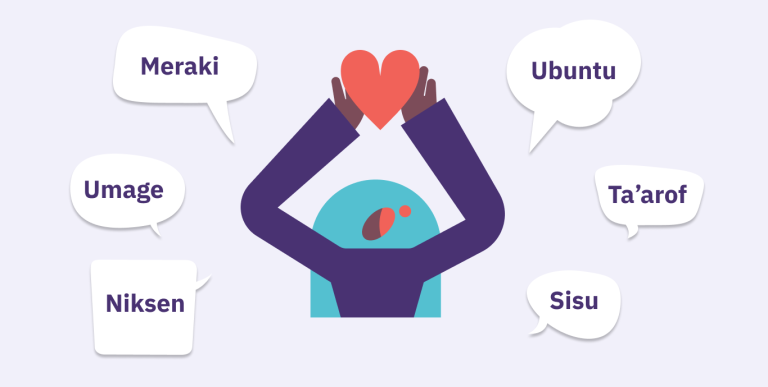What We Mean When We Talk about Remote Work

Over the past years, companies were forced to make drastic decisions in response to a drastic situation: shutting the doors of their offices. Like a flock of birds fleeing someone running through the square, employees fled busy offices for the safety of their own homes.
Remote work across the globe looked eerily similar for both new and veteran remote workers. Busy homes were now stuffed with every member of the family, for the whole day. Kitchen tables transformed to makeshift workspaces. Family members started working on top of each other, as each tried to make the new reality work for them.
Yet veteran remote workers could be heard all over the internet decrying that this was not remote work:
For new “remote workers,” experiencing work outside a traditional office for the first time, the term seemed to mean something almost entirely different than what remote work veterans were used to.
“Remote work” is a term that has been used to describe so many things by so many people that it has almost lost its meaning entirely. So let’s talk about the types of work practices hidden in this umbrella term, so we can break down “Remote Work” into more useful terms.
What is remote work?
Generally, remote work refers to:
A working style that allows professionals to work outside of a traditional office environment. It is based on the concept that work does not need to be done in a specific place to be executed successfully.
This abstract definition helps us understand the concept, but falls short of giving us a mental picture of what it looks like in practice.
It also falls short in only thinking about the individual, rather than the team. Teams that are spread across different locations are effectively having a remote work experience – working through digital collaboration tools rather than face-to-face. They are a remote team, but the definition above leaves them out.
When they hear the term “remote work”, most people think of a binary. Remote Work” is synonymous with a digital nomad lifestyle, and stands as the opposite of “In-office work” or “traditional offices”.
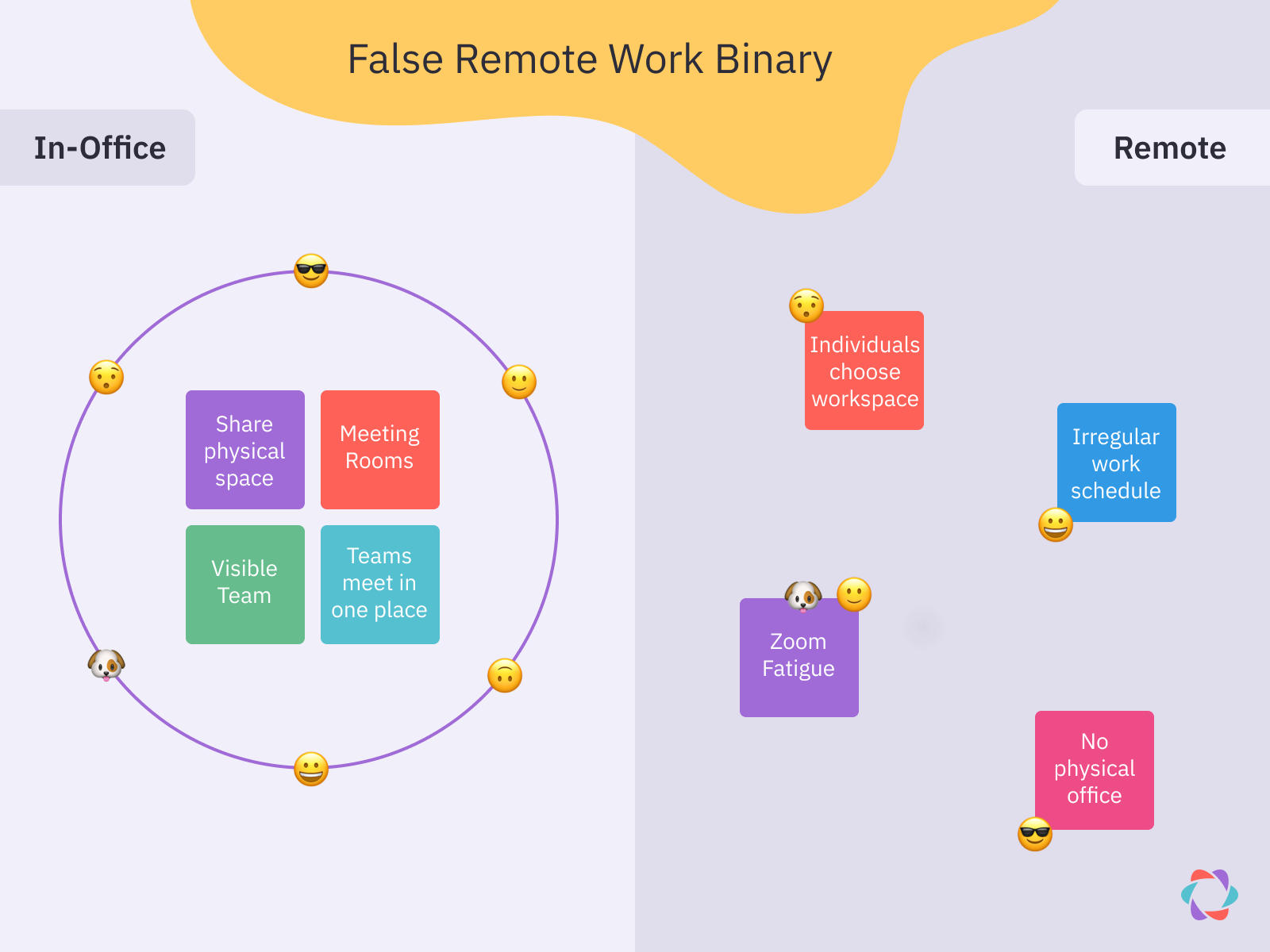
Like most things, the black-and-white binary obscures a wealth of options between both ends, as many companies are now discovering.
In practice, working styles that allow teams to work outside of and across offices can look like:
- Digital nomads, working wherever they like, and changing their location regularly
- A company with remote staff and office staff, that need to work together using digital tools
- Teams working in offices with members spread across a few different locations or countries around the world, with some overlap in working hours
- Teams with one member in a different location, whether a traditional workplace or a coffee shop
- A team in the same base location, that works from their home offices for a few days per week
- A company with staff in a few cities in the same country, that gets together only a few times a year
All of these scenarios allow for different types of flexibility and as various remote work practices have become more commonplace, different terms have cropped up to describe different types of remote practices:
- Remote-Friendly: Employees have the option to work outside of the office, but the general expectation is that they’ll be connected to a designated office where they’ll spend a significant portion of their time. Most remote work arrangements that traditional companies are adopting fall into this category. Team members working remotely in this context are ‘telecommuting,’ replacing a traditional commute with a digital one by using online tools to connect to work back at the office.
- Remote-First: Work outside the office is prioritized as the default experience, and in-office work is secondary. Remote-first companies typically still have offices, but employees visit them haphazardly.
- All Remote: Employees can work from any workspace (home office, co-working space, or other working space), anywhere in the world – the entire company is remote. The term was coined by GitLab, and, in contrast to remote-first, it refers to companies that have no offices at all.
- Fully Distributed: While practically similar to “all remote”, the term “fully distributed” is used to emphasize that a team is distributed all around the globe. The conventional wisdom is that talent is distributed all over the world, so our team should be too. But distributed teams are not as novel as you may expect.
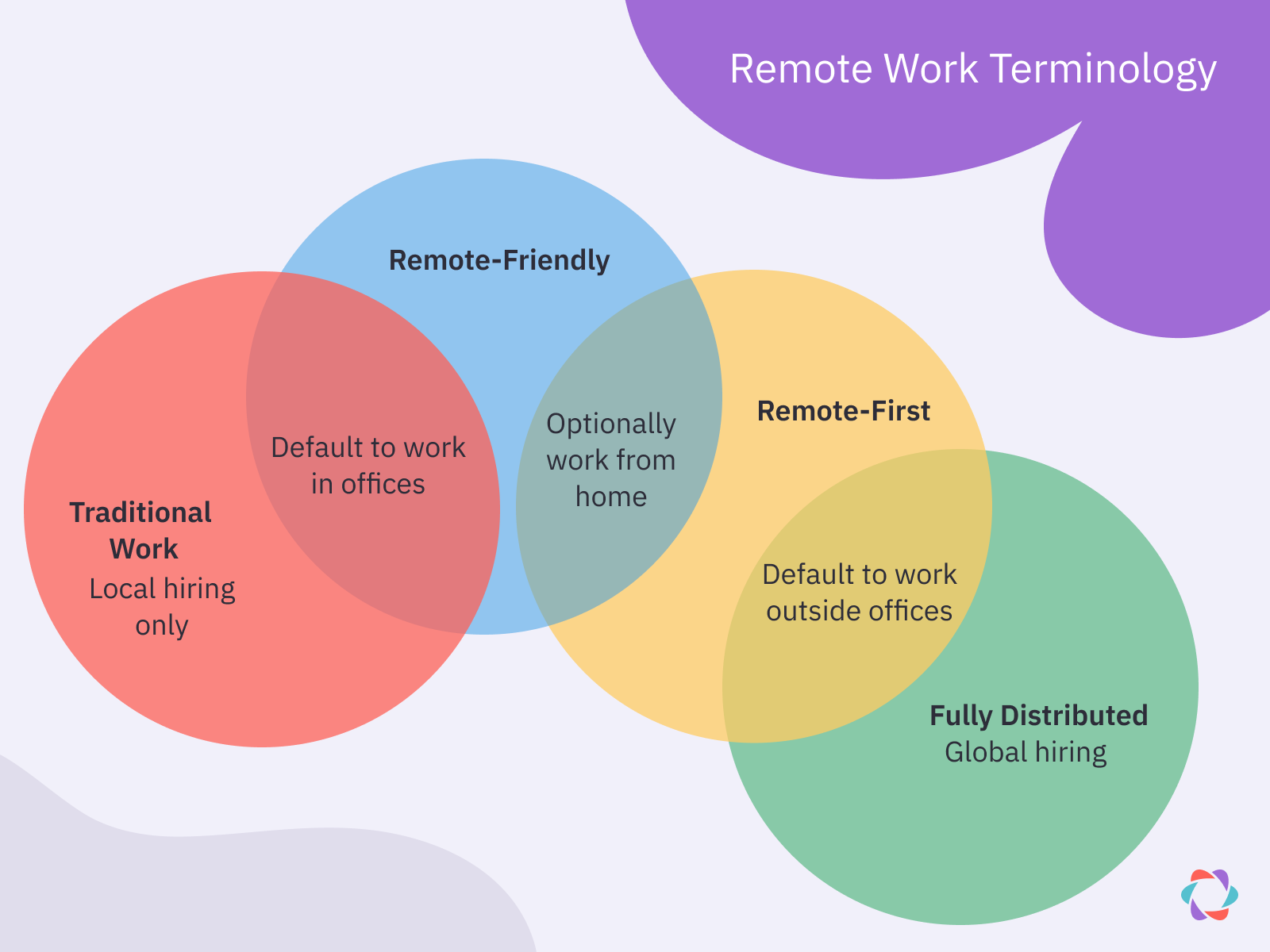
All of these terms speak to the degree of remote-ness available within a company, but not so much the flavor of remote work opportunities offered. For example, some ‘remote-first companies’ only hire in the US, which some remote work advocates claim isn’t really remote work.
If we want to have clearer conversations around remote work and craft clearer remote work policies, there are at least four dimensions to consider:
- Workspace Flexibility: the freedom to work outside company offices
- Geographic Flexibility: the option to work anywhere in the world
- Calendar Flexibility: the choice to work the hours that best suit you
- In-Person Rituals: practices for getting together as a team, to support the flexibility we want to enjoy
Clear post-pandemic remote work policies should outline your expectations across all four dimensions.
A practical definition of remote work might read:
Remote Work is an umbrella term for a variety of practices that offer employees flexibility to decide where and when they work. Remote work may mean employees can choose their workspace, where in the world they want to work, and what hours they work, or a combination of these. Remote work still includes the possibility and opportunity for working in-person from time-to-time.
Let’s dig into each of these dimensions to understand which best suits your team’s approach to work.
1. Workspace Flexibility: Allow Employees Pick a Setup that Works for Them
Most people’s experience of remote work in 2020 involved this dimension of remote work: the flexibility to work in a space outside of the company offices. During lockdowns, this wasn’t so much flexibility, as a requirement.
But in regular circumstances, office employees may want the option to choose a different workspace for a few reasons:
- Working from home so you can handle home improvements or other chores
- Working from a coffee shop to avoid distractions and enjoy the ambience
- Working from a beautiful park to get some fresh air during your workday
This is the advantage of telecommuting: the flexibility to work from a different workspace allows team members to shape their work around their life, rather than vice-versa. As we’ve written about before, everyone is remote sometimes.
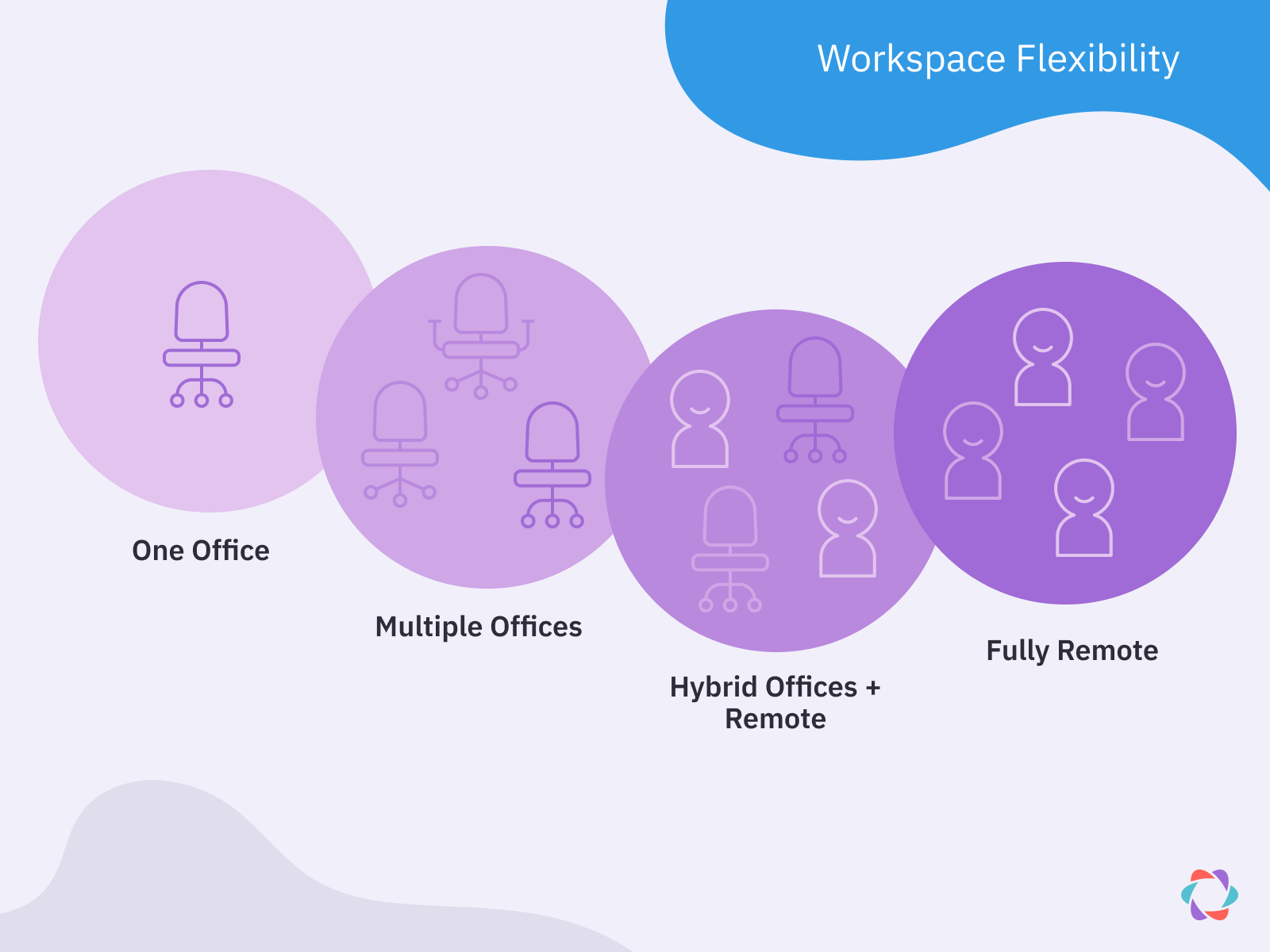
This notion of flexibility may feel intimidating, as some folks fear that it means they won’t have a dedicated company office. And employees may want a traditional office for many reasons.
For instance, they need to access materials like hardware, prototypes, proof of printed work, or even extremely high-speed internet. Or, perhaps it’s just too expensive to have dedicated workspaces within their homes or to afford a coworking space, and they need a distraction-free environment.
In these cases, workspace flexibility might include the option to access a traditional office.
Early evidence on remote work attitudes post-pandemic suggests that employees deeply value flexibility and will quit jobs that take it away. So, as leaders, we need to find ways to offer in-person or in-office experiences to team members that are energized by them, without making them required for those that do not benefit.
That’s essential for both attracting employees in the future workforce, and retaining current employees.
Practices to Support Workplace Flexibility
- HotJar offers a €4,000 home office budget to support remote employees and coworking space stipends to let team members switch up their workspaces
- Tortuga, a fully distributed company that sells backpacks for urban travelers, created this list of recommended products for a portable office. You might share this with teammates looking to hit the road.
- For teammates who are looking to build out their home office, Remote, an HR platform for remote teams, shared these recommendations.
2. Geographic Flexibility: Allow Employees See The World and Companies to Hire the Best Workers
Geographic flexibility is perhaps the second-most common flavor of remote work that people are familiar with – the option to work from anywhere in the world.
Allowing employees to work from anywhere has benefits for companies and employees alike:
- Employees can travel and see the world, or spend valuable time with relatives or friends they otherwise couldn’t see
- Companies can hire the best worker for the job, and select from a much wider workforce
For many remote work advocates, the gold standard is a fully-distributed company – which is a company without official corporate offices, where employees can work from anywhere and move around as they please. That’s what Parabol is.
While this may seem radical, many companies are already distributed to some degree.
Companies commonly have offices in multiple cities or countries, work with clients or partners in different locations around the world, and either allow employees to work from other international offices or require staff to travel to other offices for certain kinds of work.
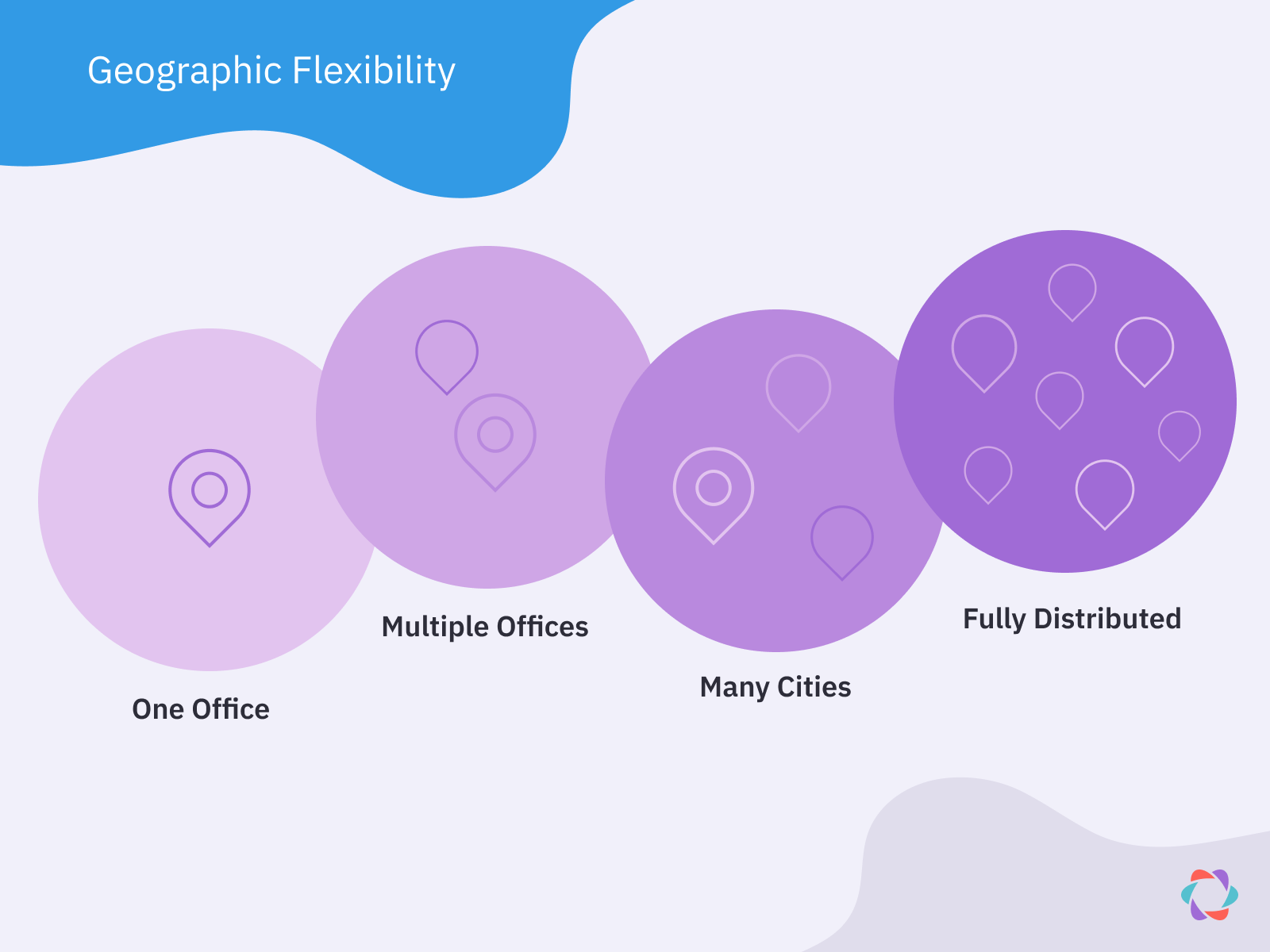
When working with people all over the world, management teams may face more challenges around cross-cultural communication and culture. As Erin Meyer writes in The Culture Map:
The sad truth is that the vast majority of managers who conduct business internationally have little understanding about how culture is impacting their work… When you exchange emails with an international counterpart in a country you haven’t spent time in, it is much easier to miss the cultural subtleties impacting the communication.
Hiring team members from different countries can improve on these challenges – with in-house experts to bridge the cultural divide – or exacerbate them, if you haven’t been sensitive to differences in culture with your own teammates.
By the same token, working across time zones is a unique challenge for more geographically flexible teams and can also be a boon or bane.
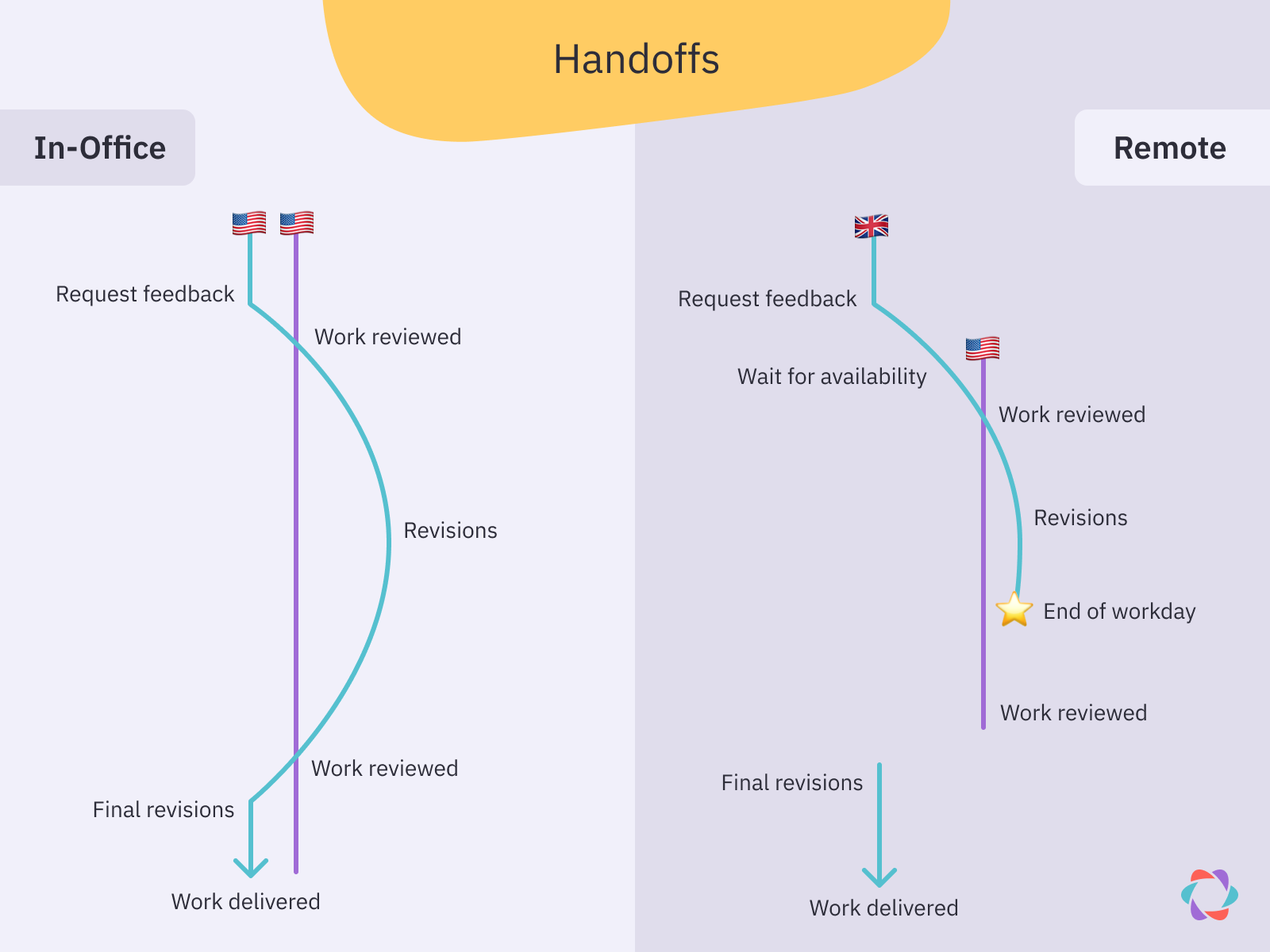
In the best cases, the sun never sets on your productivity, as team members hand off work seamlessly as others are waking up. In the worst case, work slows down as remote employees wait for the next person to wake up in order to get an answer and keep going.
Practices to Support Geographic Flexibility
- Atlassian, the global 5,700-employe company behind Jira and others, is letting employees work from anywhere, as long as the company has a corporate entity in the country, the employee has the legal right to work in that country, and they’re broadly aligned with the time zones of the rest of the team. They’re offering geographic flexibility, but with certain boundaries to ensure legality and team cohesion.
- Erich Wegscheider, who works in recruiting operations, wrote about transitioning from working North American to Asia Pacific working hours while working at GitLab
- Arc, a developer hiring platform, shares these tips for managing work across time zones from their own experience, as well as remote companies like Zapier and Help Scout
- Mike Eckstein, Product Marketing Manager at Buffer who is based in Australia, shared their personal tips for being in a more geographically distributed team.
3. Calendar Flexibility: Allows Workers to Find their own Working Rhythm
While positive conversations around remote work often center around the flexibility workers have to choose their workspace, frustrations around remote work often center around a lack of flexibility when it comes to their working hours.
The now-dreaded Zoom meeting is an iconic symbol of the kind of remote work environment we’ve experienced over the last year. It’s a logical first step to try to replicate the office environment remotely through video calls and real-time chat tools, but it’s one that restricts workers from finding a flexible schedule that truly works for them and it can result in burnout.
Calendar flexibility is part of this conversation on remote work for three reasons:
- When no longer bound by the confines of a traditional office, being bound by the same expectations for when to start and end your day starts to feel silly. Workers begin to push on business hours.
- In the context of non-traditional workspaces, time starts to be more fluid. Team members, intentionally and by accident, flex their work time around the constraints of their personal lives. Especially if you’re working from home, these flexible hours are key to finding work-life balance.
- Without the tools of walking around to see who is working or pulling people into a conference room, management teams may impose other synchronous activities as a means of keeping the reins in their hands. Left unchecked, this can create really negative experiences for employees, hence the dreaded all-day Zoom meeting or feelings of having to appear present by instantly answering IMs, even if you’re deep in focus mode.
When sharing physical offices, team members can count on being together at the same time. When not sharing an office, team members can no longer assume they’ll be working at the same time.
In the field of remote work, two modes of work are often discussed: synchronous and asynchronous work.
In asynchronous work, an individual works on something, then hands it off to one or more other people to input their thoughts in their own time. Each participant is working individually, over time, on the same thing. In synchronous work, several team members have their attention on the same thing at the same time. Everyone is working together, at the same time, on the same thing.
When deciding what kind of calendar flexibility to offer, consider how much collaboration is needed in your day-to-day work. Ask yourself, how much can be done synchronously and how much can be done asynchronously?
♟️ Asynchronous tasks: Some types of work are best done individually, by expert contributors working alone. Crafting tasks, such as writing code, creating high-fidelity designs, writing a blog post, analyzing data, or anything that involves considering deep details, are often better single-player activities that lend themselves well to async cycles of work.
🏓 Synchronous tasks: Other work benefits from being shaped together. Tasks like jamming on a song, brainstorming of any kind, and sometimes decision-making (processing feedback, iterating on ideas) are more effectively done through the fast cycles of synchronous work, perhaps by multiple people on a call or working together in a shared space.
Depending on the kinds of work that your team does, you may want to optimize calendar flexibility to make one or the other mode easier.
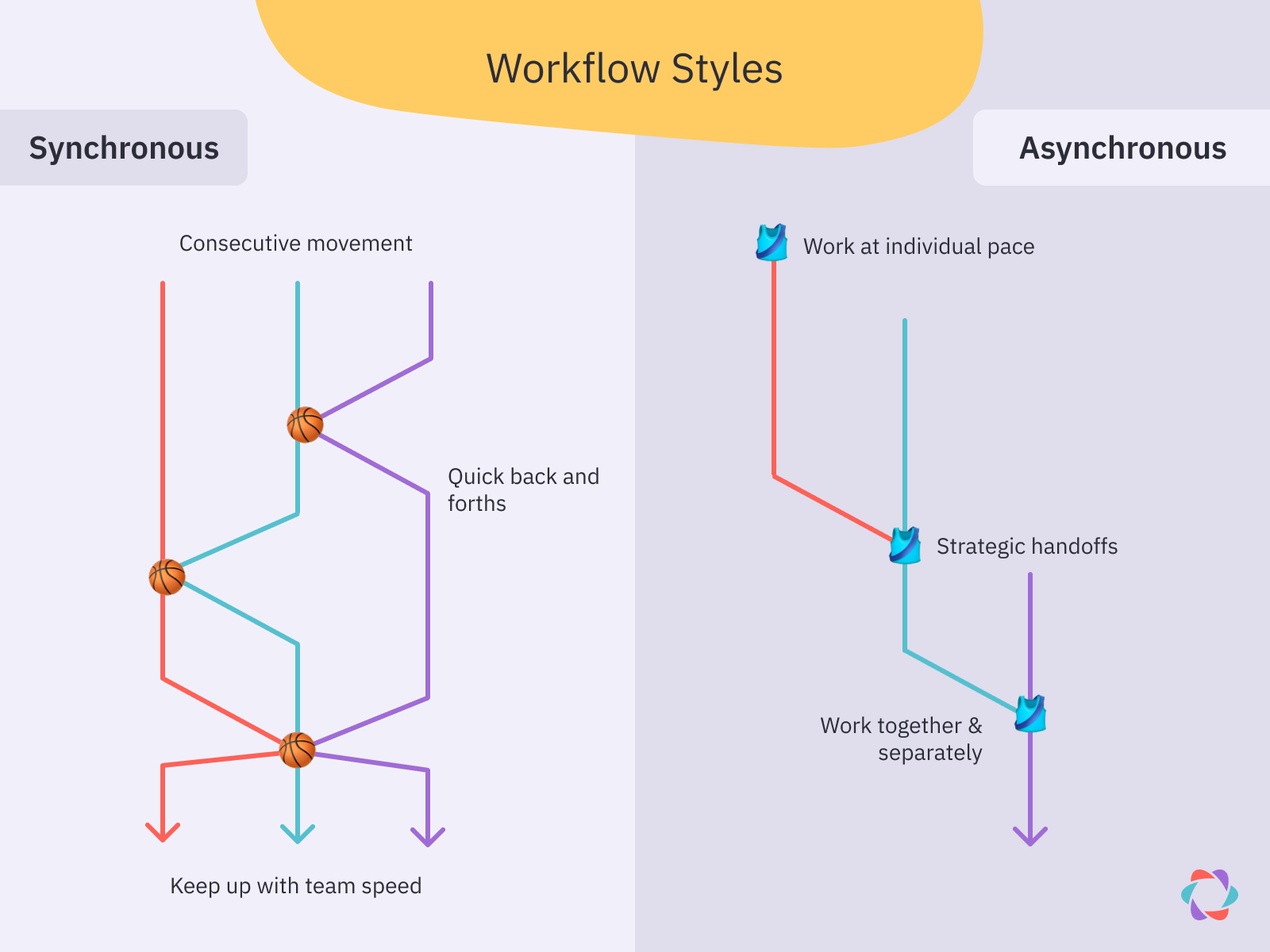
Practices to Support Calendar Flexibility
- Brian de Haaff, CEO at Aha!, wrote about intentionally structuring communications to decrease meeting times and Zoom fatigue, ultimately giving employees more flexibility.
- Shifting to text-based communication for meetings that don’t require quick feedback, like this text-based standups practice from Erin Folletto, a senior product design director and coach.
- At Parabol, even decision making is an asynchronous activity to allow for more calendar flexibility.
4. In-Person Rituals: Allow Employees and Teams the Flexibility to Flourish
As companies have started talking about going ‘back to the office’, we’ve seen a rise in a new term: hybrid work. 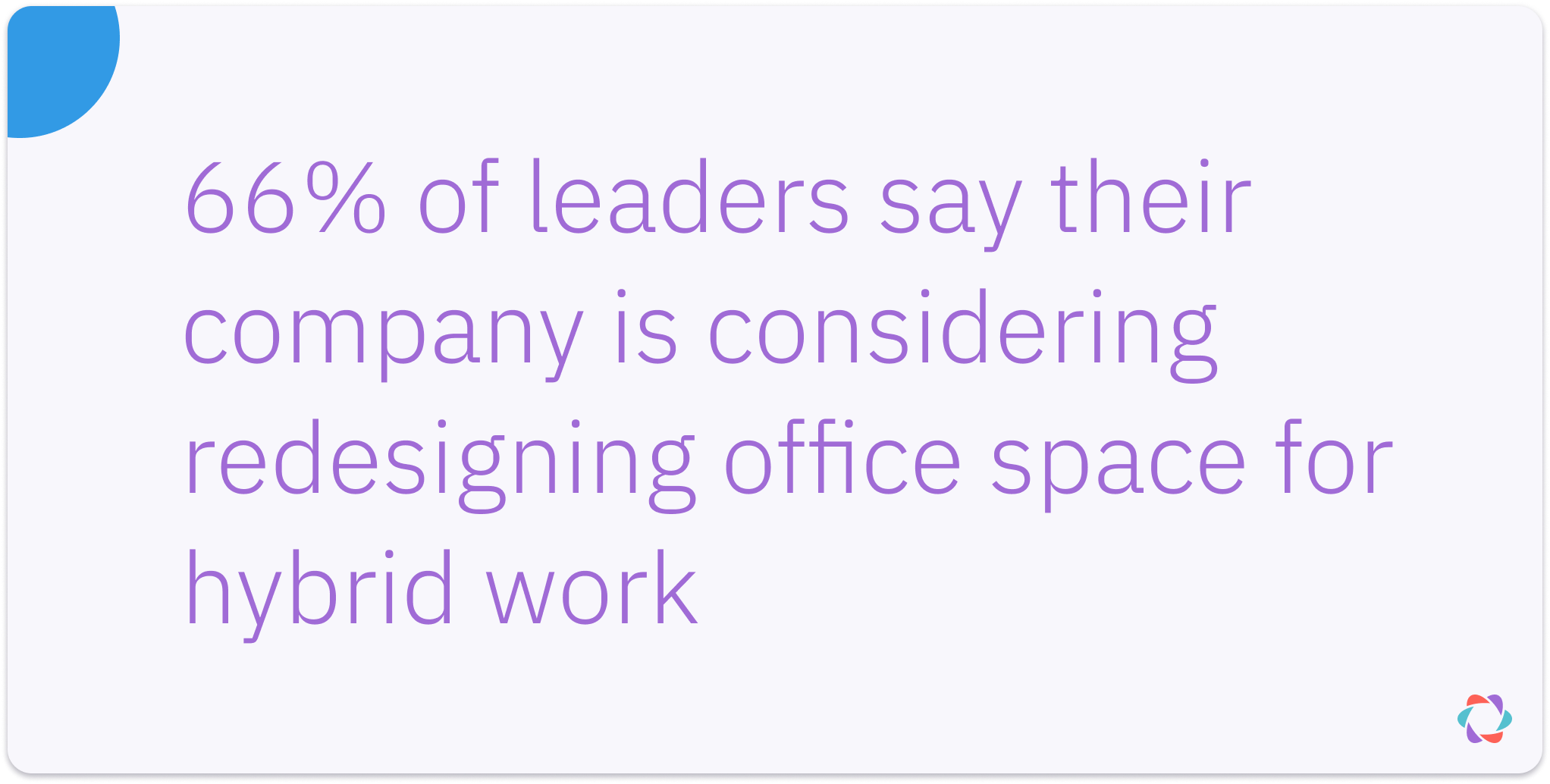
A hybrid work environment means a mix of remote and in-office work. In practice, that refers to asking employees to come into the office a set number of days per week, and offering flexibility on other days.
Some might also call this ‘remote-friendly’.
However, as we’ve seen, remote work isn’t a binary, but a spectrum, across multiple dimensions. The concept of a ‘hybrid work environment’ is misleading. Just as everyone is remote sometimes, all work is hybrid to some extent.
For remote work to work, the question isn’t whether your team will get together in person, but who will get together and how often.
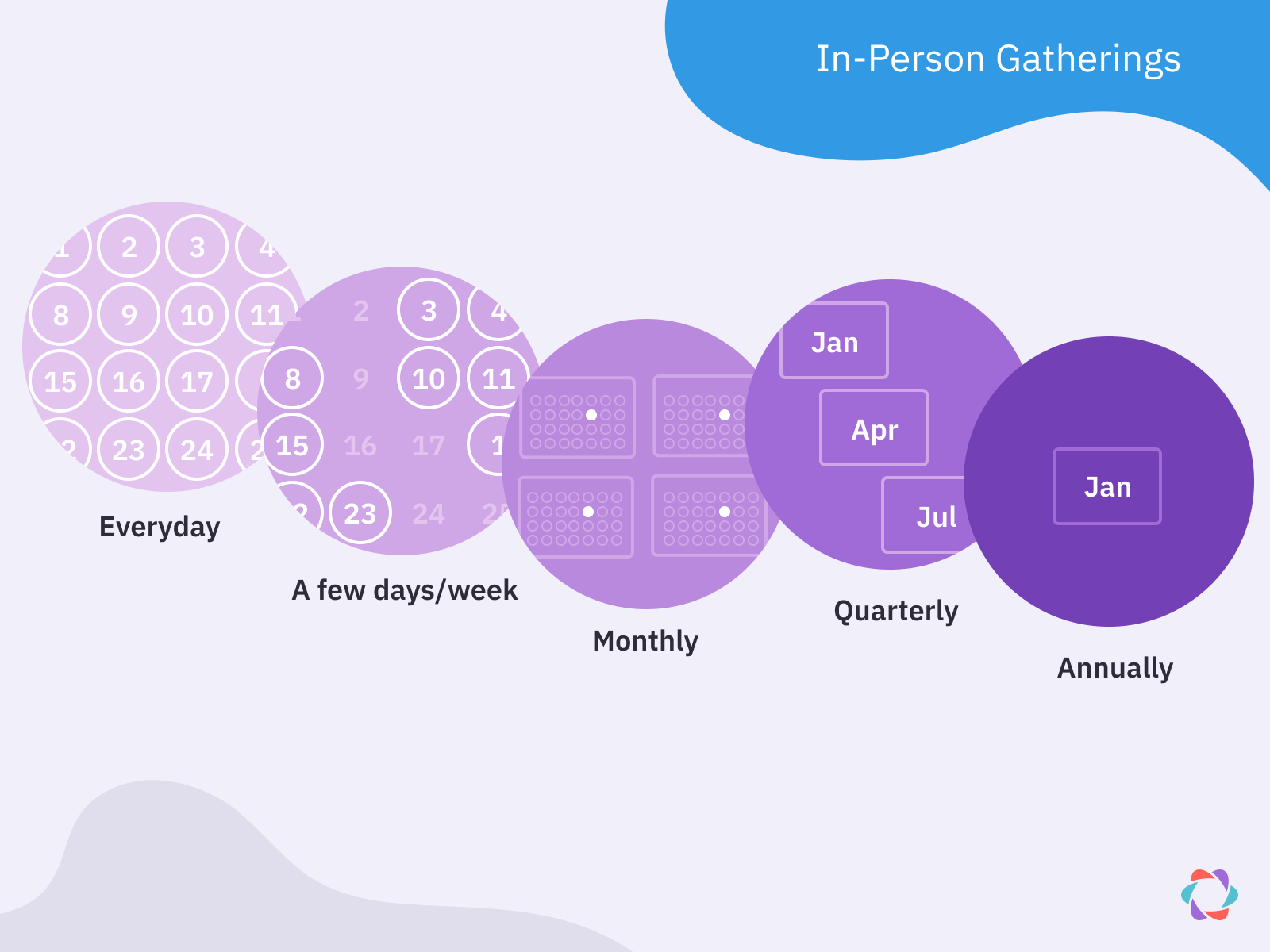
Some workers may crave the camaraderie of being physically around their coworkers. Or, similar to the cycles of synchronous or asynchronous work, teams may find that there are critical points along a project or times of year when coming together is particularly valuable. To find the right rituals, consider the kind of work you do and the existing rhythms you have.
At Parabol, we find that coming together on a quarterly basis allows us to ‘reconnect’ and ‘resync’ our thinking.
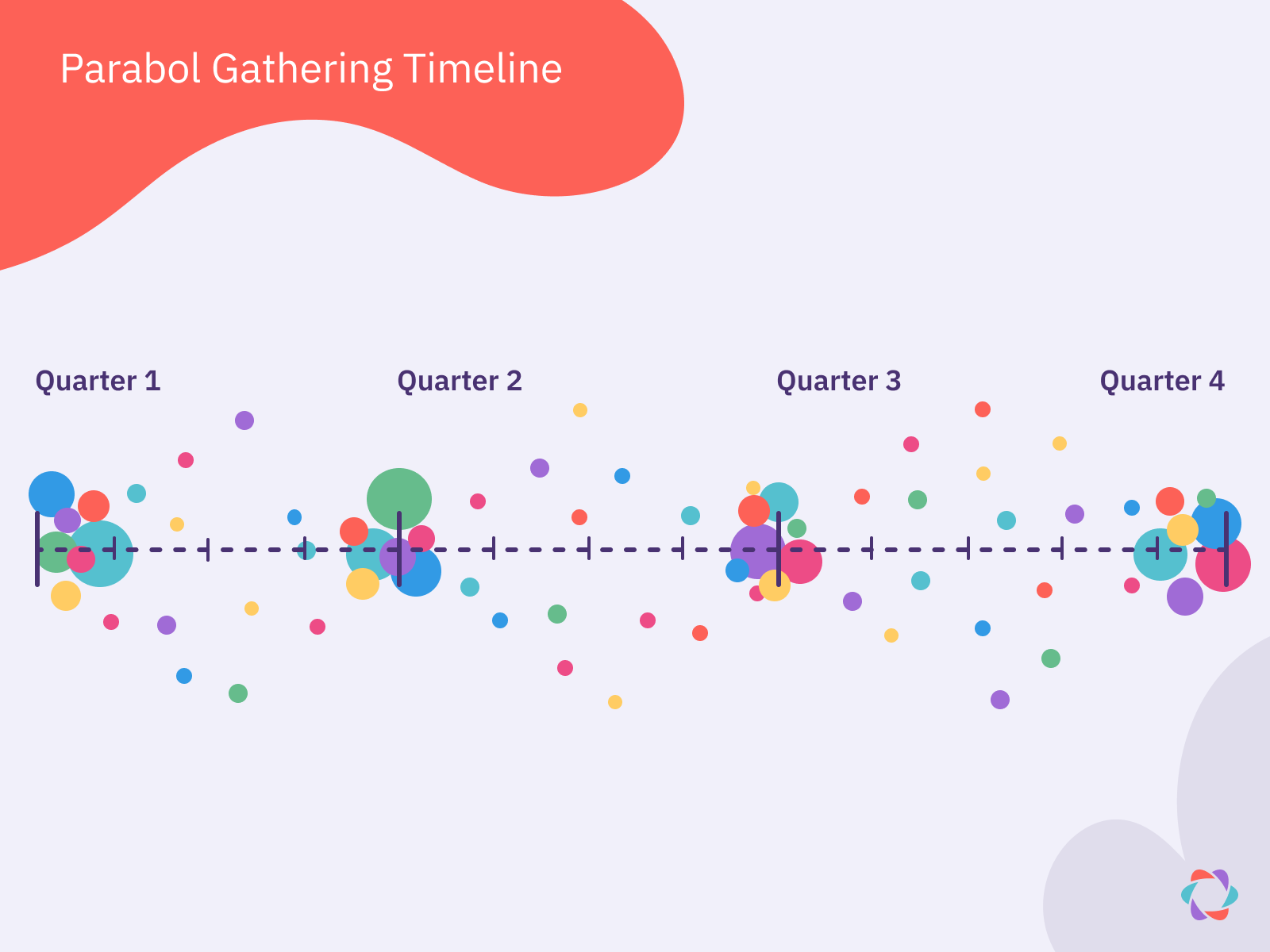
By intentionally thinking about when, how and who meets up in-person, you can healthier remote work options.
One word of caution though: some folks may say they want in-person collaboration, when actually they need a better workspace – more quiet, more kid-free, further away from their bedroom. In setting your expectations around when team members have to get together, dig deep to understand the true need, so you can find the right support.
In-Person Rituals to Support Remote Work
- Automattic, where I used to work, does a yearly all-company retreat and encourages teams to meet up for smaller team retreats 1-2 times per year. Automattic also has over 1,000 employees.
- In a user research call, one product manager at a large company shared that employees would get together for monthly happy hours to enjoy some in-person, outdoor, distanced socializing while working-from-home during a lockdown. Similar practices can continue beyond this transition.
- Doist, a fully distributed company of about 90, recommends work-related meetups and finding a coworking group to get some in-person experiences while working remotely.
- Parabol, in pre-pandemic times, did 3-4 in-person all-company retreats per year. As a small company of less than 5 people before the pandemic, that cadence felt appropriate.
Deciding what remote work means for your team or organization
As the world transitions from the great work-from-home experiment, to a new work reality, many companies are facing a unique challenge: how do we bring forward what team members like about their new-found flexibility, while building company cultures that can last?
Different companies have adopted different terms to better describe how remote a company’s culture truly is, but none of the existing terms speak to the kinds of remote work options available.
To have deeper conversations with our teams and craft better company policies, we looked at four dimensions of remote work:
- Workspace flexibility
- Geographic flexibility
- Calendar flexibility, and
- In-person rituals.
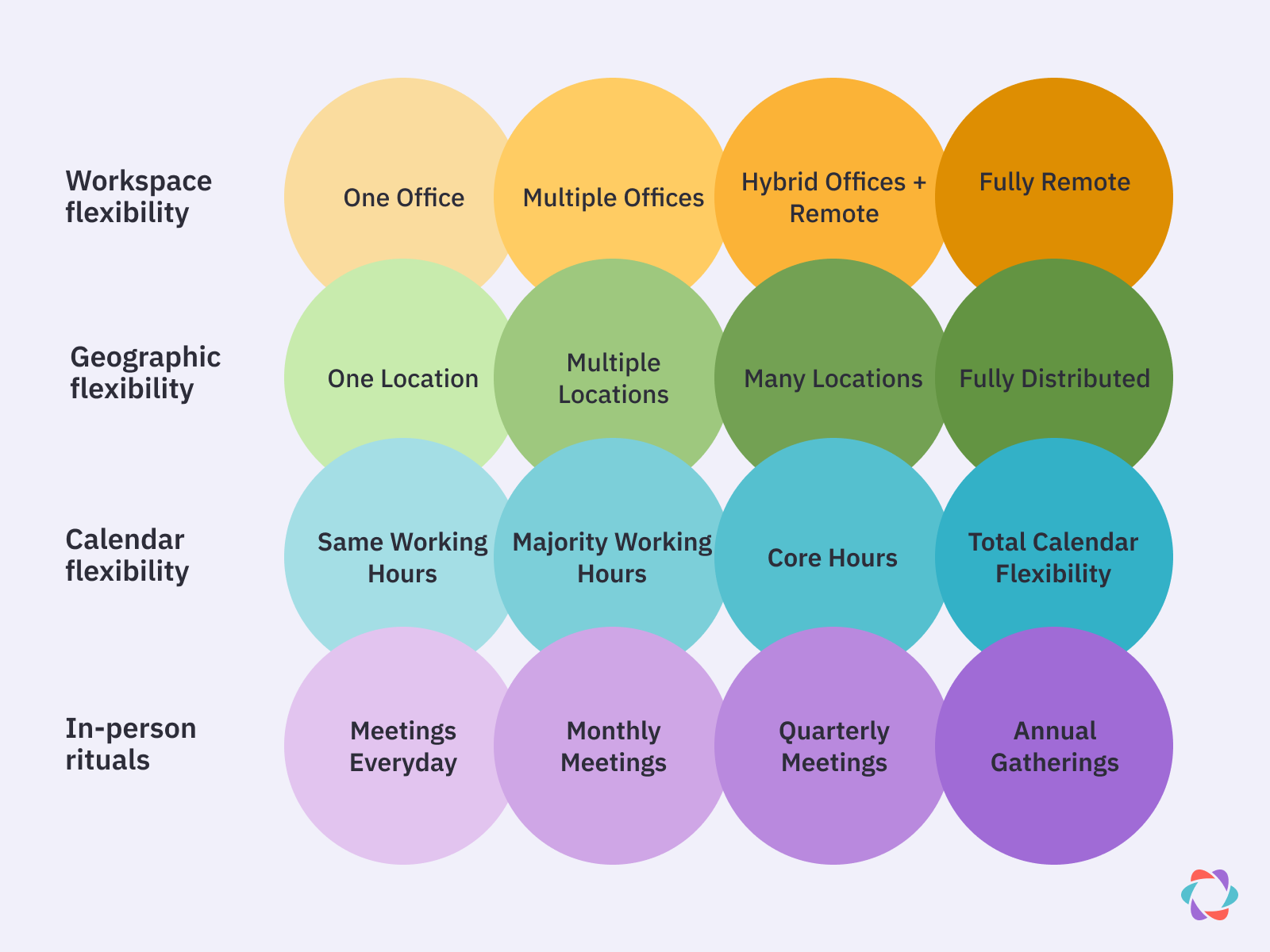
To turn this thinking into action, you can:
- Introduce this framework to your team: Share this post to start a conversation in a team meeting or at a dedicated time about the upcoming transition.
- Evaluate the types of flexibility you and your team need or want: Whether through a poll on these four categories, or a retrospective with a custom template asking about these dimensions, get feedback from your team on what specifically matters to them.
With this new framework in hand, I hope we can define remote work in ways that feel meaningful for each of our teams.
Have you talked to your team about these dimensions of remote work? Find some interesting insights or trying out new processes for supporting flexibility? We’d love to hear about it!

